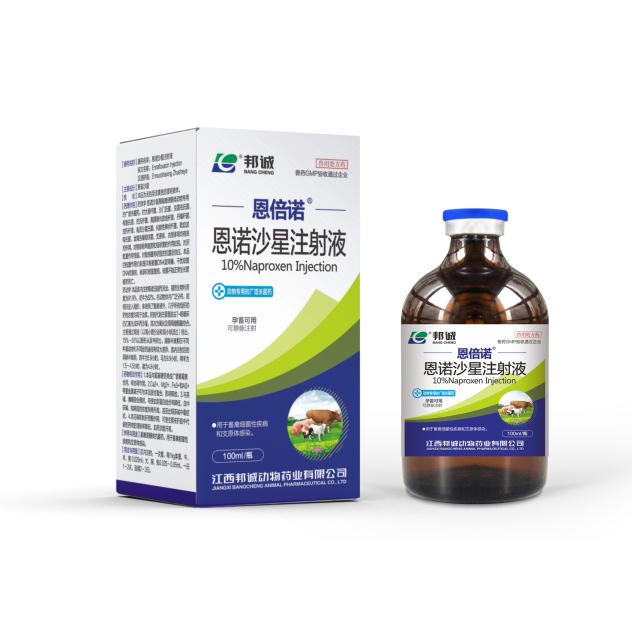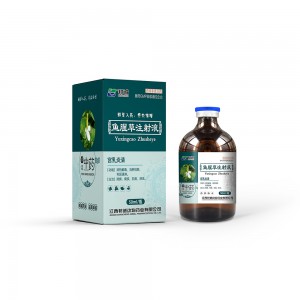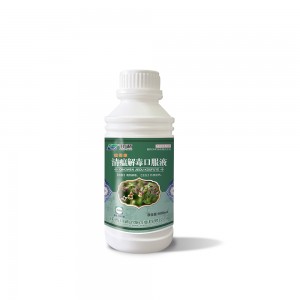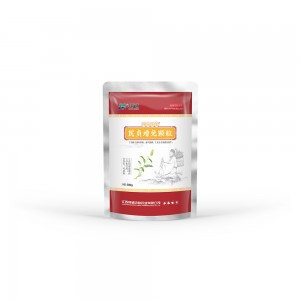Pharmacodynamics enrofloxacin is a broad spectrum bactericidal drug for fluoroquinolone animals. It has a good effect on escherichia coli, salmonella, klebsiella, brucella, pasteurella, actinobacillus pleuropneumoniae, erysipelas, proteus, serratia marcescens, corynebacterium pyogenes, portococcus septicus, staphylococcus aureus, mycoplasma, chlamydia, etc. It has a weak effect on pseudomonas aeruginosa and streptococcus, and a weak effect on anaerobic bacteria. It has obvious post-antibacterial effect on sensitive bacteria. The antibacterial mechanism of this product is to inhibit bacterial dna rotation enzyme, interfere with bacterial dna replication, transcription and repair recombination, bacteria can not grow and reproduce normally and die.
Pharmacokinetics the intramuscular absorption of this product is rapid and complete, with a bioavailability of 91.9% in pigs and 82% in dairy cows. It is widely distributed in animals and can enter tissues and body fluids well, except cerebrospinal fluid, the concentration of drugs in almost all tissues is higher than that in plasma. The liver metabolism is mainly to produce ciprofloxacin by removing the ethyl of 7-piperazine ring, followed by oxidation and glucuronic acid binding. It is mainly excreted by the kidneys (by renal tubule secretion and glomerular filtration), and 15% to 50% is excreted from the urine in its original form. The elimination half-life varies greatly in different species and different routes of administration. The elimination half-life after intramuscular injection is 5.9 hours in cows, 9.9 hours in horses, 1.5 to 4.5 hours in sheep, and 4.6 hours in pigs.
1. This product has synergistic effect when used with aminoglycoside or broad-spectrum penicillin.
2. Heavy metal ions such as ca2+, mg2+, fe3+ and al3+ canchelate with this product and affect the absorption.
3. When combined with theophylline and caffeine, it can reduce the binding rate of plasma protein, abnormally increase the concentration of theophylline and caffeine in blood, and even appear theophylline poisoning symptoms.
4. This product has the effect of inhibiting liver drug enzymes, which can reduce the clearance rate of drugs mainly metabolized in the liver and increase the blood drug concentration.
Fluoroquinolone antibacterial drugs. Used for livestock and poultry bacterial diseases and mycoplasma infection.
Intramuscular injection: One dose, 0.025ml per 1kg body weight of cattle, sheep and pigs; 0.025 ~ 0.05ml for dogs, cats and rabbits. Use 1 to 2 times a day for 2 to 3 days.
1. Cartilage degeneration in young animals, affecting bone development and causing lameness and pain.
2. The reaction of digestive system includes vomiting, loss of appetite, diarrhea and soon.
3. Skin reactions include erythema, pruritus, urticaria and photosensitivity.
4. Allergic reactions, ataxia, seizures are seen in dogs and cats.
1. It has a potential excitatory effect on the central system, inducing epileptic seizures, and should be used with caution in epileptic dogs.
2. Carnivores and animals with poor kidney function should be used with caution, which can occasionally cause crystalline urine.
3. This product is not suitable for horses. Intramuscular injections are transient irritants.
4. This product should not be used in dogs before 8 weeks of age.
5. The drug resistant strains of this product are increasing and should not be used in subtherapeutic doses for a long time.







